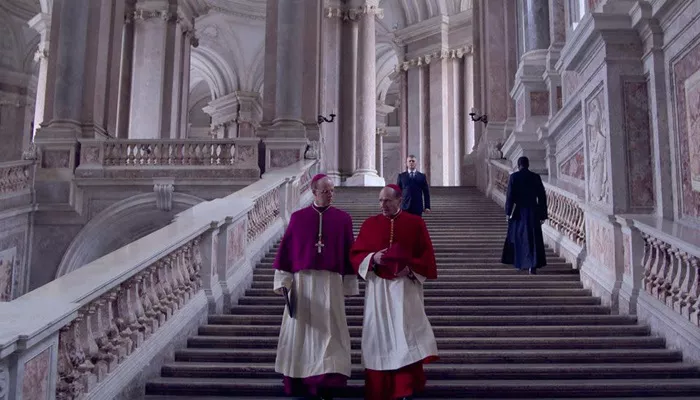A Behind-the-Scenes Look at the Papal Selection Process
“Conclave,” the recent film directed by Edward Berger, offers a dramatic portrayal of the intense political and religious process behind the election of a new pope. Featuring a stellar cast, including Ralph Fiennes, Stanley Tucci, Isabella Rossellini, and John Lithgow, the movie is based on Robert Harris’s 2016 thriller, which imagines the power struggles within the Vatican during a papal conclave.
The Plot: Politics, Faith, and the Fight for Power
The movie opens with a powerful scene showing key figures of the Catholic Church gathered around the body of a recently deceased pope. The focus of the film is on the inner workings of the conclave—a secretive gathering where cardinals come together to elect a new pope. While the film touches on themes of faith and tradition, it primarily highlights the behind-the-scenes politics that drive the selection process.
In the movie, the Vatican’s senior officials wrestle with their ambitions and desire for power, all while maintaining the appearance of piety and humility. A central theme is the tension between progressives and conservatives within the Church, with characters struggling to navigate their personal beliefs and the political reality of the papal election.
Church Reactions: Critics from Within
Despite the movie’s success, it has faced criticism from some figures within the Catholic Church. Bishop Robert Barron, a well-known Catholic figure and founder of Word on Fire, dismissed the film on social media, warning his followers to “run away from it as fast as you can.” He criticized the movie for promoting progressive ideas such as diversity and inclusion while portraying the Church’s hierarchy as a “hotbed of ambition, corruption, and egotism.” He also took issue with the film’s portrayal of conservatives as “xenophobic extremists” and liberals as “self-important schemers.”
A Battle for the Soul of the Church
“Conclave” presents a fictional but gripping scenario of a divided Church, where the election process becomes a battle between traditional values and the push for reform. The movie’s storyline highlights the key issue facing real-life cardinals in papal elections: whether to continue the open-minded direction set by Pope Francis or to shift towards a more conservative approach.
Steven P. Millies, a theologian, pointed out that the real-life conclave process is a careful balancing act, blending coalition-building with spiritual guidance. He emphasized that while the process is political in nature, it is also a moment for cardinals to seek the Holy Spirit’s guidance in choosing the right leader for the Church.
The Conclave Process: Secrecy and Rituals
The film captures the secrecy of the conclave process, where cardinals are secluded from the outside world to ensure their decisions are free from external influence. As depicted in the movie, cardinals are not allowed to communicate with anyone outside the conclave, even prohibiting them from reading news reports or receiving messages.
In real life, only cardinals under 80 are eligible to vote. They gather in the Sistine Chapel, where they cast their ballots in front of Michelangelo’s iconic “Last Judgment.” After each voting session, the ballots are burned, and the color of the smoke rising from the chimney signals whether a pope has been chosen—white smoke for a new pope, black for no decision.
Realism and Accuracy in the Film
“Conclave” makes a notable effort to accurately depict the papal election process. The filmmakers were granted a private tour of the Sistine Chapel, and the movie includes many authentic details. We see cardinals arriving with their luggage, the ceremonial sealing of the pope’s room, and the destruction of his ring—all parts of the actual process. The film also accurately portrays the use of chemicals to create the distinct smoke signals.
However, some minor inaccuracies exist, such as the arrangement of the tables in the Sistine Chapel and the way cardinals address each other. The most significant criticism, though, is the film’s ending, which some have found to be improbable and overly dramatic.
Critics and Praise: Mixed Reactions
Tom Reese, a Jesuit priest and church commentator, acknowledged the film’s strong acting and production values but criticized the plot twists as “bizarre and unbelievable.” On the other hand, Millies, the theologian, viewed the movie as more than just a political drama. He described it as a personal journey of one cardinal’s struggle with his faith, which he found “beautiful to watch.”
A Movie About Faith and Politics
In the end, “Conclave” is not just a political thriller; it’s also a story about personal transformation and faith. While it offers a realistic portrayal of the papal election process, it also dives into the emotional and spiritual challenges faced by the men involved. Despite its flaws, the film provides an engaging look at one of the most secretive and important processes within the Catholic Church.
Related Topics
“Conclave” and “The Brutalist” Shine at BAFTA Film Awards
Conclave Hits Key Box Office Milestone Ahead of Awards Season
‘Conclave’ Movie: Major Plot Flaw, Says Pope Expert

